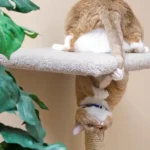Spring is a time of beauty—flowers bloom, the sun warms up, and the garden comes alive. But if you share your home or backyard with a curious feline, some of those pretty plants can quietly pose a risk. One question many cat parents ask is: are daffodils poisonous to cats? The short answer? Yes, they are.
But don’t panic just yet. Knowing the risks—and what to do—can help you keep your cat safe and your home just as lovely.
What Makes Daffodils Dangerous to Cats?
Daffodils may be beautiful, but they contain lycorine, a toxic alkaloid that’s dangerous to cats (and other animals, too). Every part of the daffodil is poisonous—the bulb stems, leaves, and flowers. But the bulb is especially potent.
Lycorine can trigger various symptoms when a cat chews on or eats any part of the daffodil. It doesn’t take a considerable amount to make a cat sick. Even brushing against the pollen and then licking it off their fur could lead to mild symptoms.
Cats don’t need to eat an entire plant to react. Just a small nibble or exposure to pollen can be enough to cause trouble. That’s why treating all parts of the plant as unsafe is essential.
Common Symptoms of Daffodil Poisoning in Cats
If your cat has nibbled on a daffodil, keep an eye out for any of the following symptoms:
- Drooling
- Nausea or vomiting
- Diarrhea
- Abdominal pain
- Loss of appetite
- Trouble breathing
- Lethargy or weakness
- Shaking or tremors
In more severe cases, poisoning can also lead to heart rhythm issues or seizures, mainly if a cat eats a large amount of the bulb. The symptoms can develop quickly, and you might notice changes within a few hours.
How Fast Do Symptoms Show Up?
Usually, symptoms appear quickly—within a few hours of ingestion. That means time is critical. If your cat shows any signs of daffodil poisoning, don’t wait. Contact your vet or a poison control center right away.
Even if the symptoms seem mild at first, they can get worse. Acting early is the best way to prevent complications.
What to Do If Your Cat Eats a Daffodil
If you catch your cat in the act—or find chewed stems or petals on the floor—try not to panic. Here’s what to do:
- Remove access to the plant immediately.
- Wipe your cat’s mouth and fur (gently) with a damp cloth to remove any pollen or residue.
- Call your vet or a pet poison helpline and describe what happened.
- Follow your vet’s advice, including bringing your cat in for observation or treatment.
Depending on how much your cat ingested and the symptoms present, your vet may induce vomiting, give activated charcoal to absorb the toxins or provide IV fluids and medications to stabilize your cat.
If you have the plant label or know exactly what kind of flower your cat chewed, take a photo or bring the plant with you. This helps the vet know precisely what they’re dealing with.
Can Cats Die from Daffodil Poisoning?
While many cases of daffodil poisoning are mild and treatable, severe poisoning can be fatal—especially if left untreated. The risk is highest if your cat consumes the bulb or if they’re very young, old, or already ill.
The quick treatment makes all the difference. Most cats recover fully with proper care, but waiting too long can endanger your furry friend.
In rare cases, heart issues and convulsions may develop if the poisoning is severe and not treated in time. Don’t assume your cat will just “sleep it off.”
Why Do Cats Eat Daffodils?
It’s easy to think cats “should know better,” but they’re naturally curious. They love to chew, sniff, paw, and play with new things—especially plants that move in the breeze or have bright colors.
Some cats also chew plants out of boredom, anxiety, or nausea. Indoor cats without access to safe greenery may go straight for your floral bouquet. Others are just exploring their environment with their mouths, especially kittens.
Even the smell of a daffodil might attract a cat, especially if the flower is mixed in with other non-toxic plants. It’s not about being hungry—it’s often about being stimulated.
Safe Alternatives to Daffodils for Cat Homes
You don’t have to give up your love for greenery to keep your cat safe. Here are a few pet-safe plants to brighten your space:
- Spider Plant
- Areca Palm
- Calathea
- Bamboo Palm
- African Violets
- Cat Grass (they’ll love this one!)
- Prayer Plant
- Boston Fern
These plants are non-toxic to cats and can add as much beauty to your home without the risk. If you’re unsure whether a plant is safe, the ASPCA has an excellent online list of toxic and non-toxic plants for pets.
Daffodils in the Garden: What You Should Know
If you grow daffodils outdoors, you don’t necessarily need to dig up your whole garden. Just make sure your cat can’t get to them:
- Use fencing or netting to block access.
- Keep your cat indoors during the bloom season.
- Plant daffodils in containers and elevate them.
- Remove cut daffodils before bringing them inside.
Be extra cautious if you’re a cat foster parent or live in an area with many neighborhood cats. Some curious strays may wander into your garden, especially in the spring.
Even dried daffodils or dead plant parts can still be harmful, so dispose of them properly.
Preventing Accidental Exposure Indoors
It’s not just gardens that can pose a risk. Florists often include daffodils in spring arrangements. These bouquets can end up on dining tables, desks, or windowsills—all places your cat loves to jump onto.
To keep your cat safe:
- Avoid buying mixed bouquets with daffodils.
- Tell friends and family not to send flowers with toxic blooms.
- Place any risky arrangements in off-limits rooms.
- Educate anyone who watches your cat while you’re away.
Cats are agile and curious. If there’s a flower in reach, they will find it.
FAQs
Are daffodils poisonous to cats?
Yes, daffodils are toxic to cats. They contain lycorine, which can cause vomiting, diarrhea, and other severe symptoms if ingested.
Can a small bite from a daffodil hurt my cat?
Even a small amount can cause mild symptoms, especially if your cat is sensitive or very young. It’s always best to get vet advice right away.
What part of the daffodil is the most toxic?
The bulb is the most toxic, but every part of the plant harms cats, including the leaves and flowers.
Can touching daffodils hurt my cat?
Yes. Pollen or sap on your cat’s fur or paws can be ingested during grooming, leading to mild poisoning.
What are some signs of daffodil poisoning in cats?
Watch for vomiting, diarrhea, drooling, lethargy, and loss of appetite. Severe cases may involve tremors or irregular heartbeat.
Are other spring flowers dangerous to cats too?
Yes. Tulips, lilies, and hyacinths are also toxic to cats. Always check plant safety before bringing any flowers into your home.
Final Thoughts: A Safer, Happier Home for You and Your Cat
Daffodils may light up a room, but they’re not worth the risk if your cat is around. Plenty of safe, beautiful alternatives won’t put your feline friend in danger.
As cat parents, our homes are a shared space. It’s up to us to make them feel safe and loved—which means learning what’s dangerous, even in the form of a pretty flower.
So the next time you’re arranging a spring bouquet or planning your garden, just pause and ask: “Is this safe for my cat?”
Because that tiny question might make all the difference—and your curious little explorer will thank you for it with a soft purr and a gentle nuzzle.





GIPHY App Key not set. Please check settings